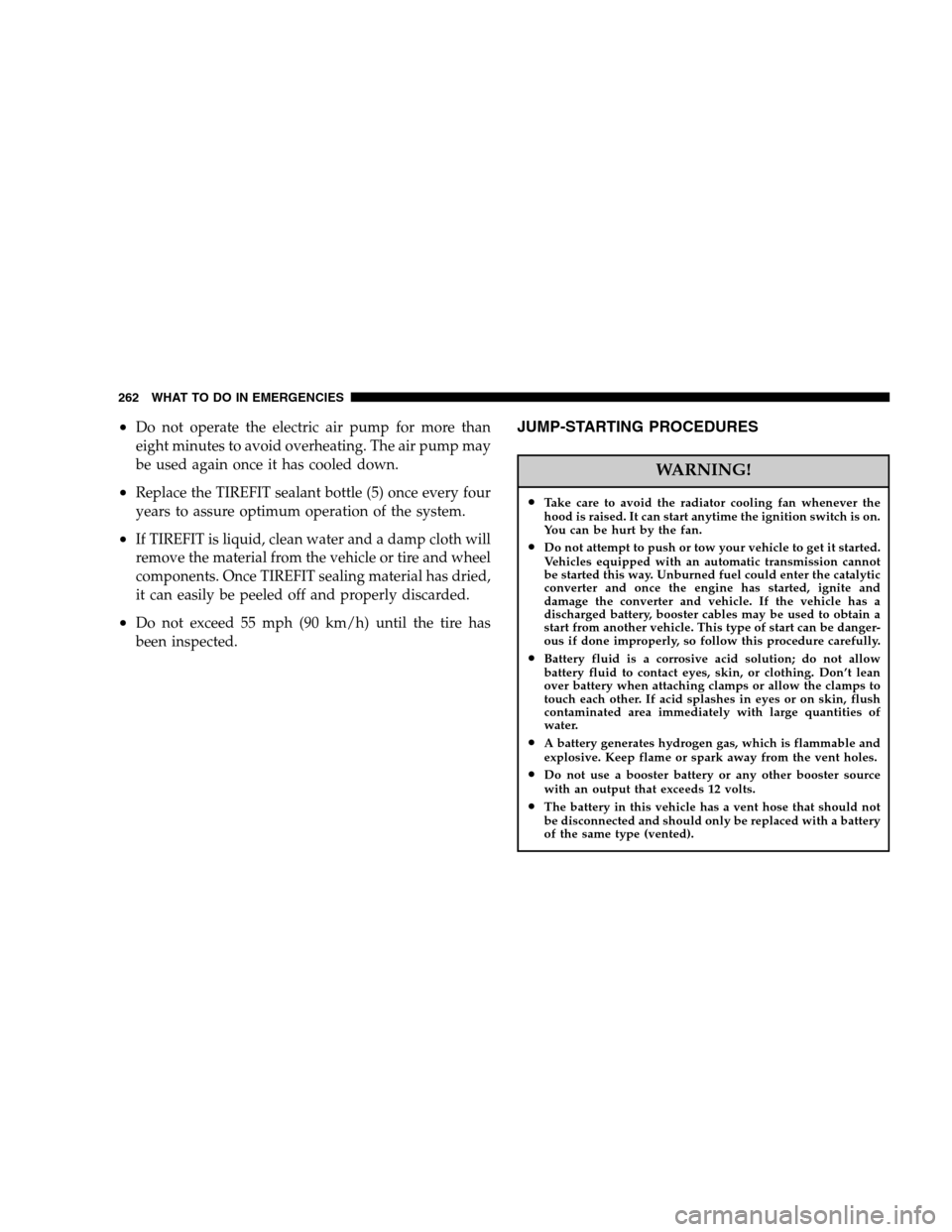Page 262 of 360

•Do not operate the electric air pump for more than
eight minutes to avoid overheating. The air pump may
be used again once it has cooled down.
•Replace the TIREFIT sealant bottle (5) once every four
years to assure optimum operation of the system.
•If TIREFIT is liquid, clean water and a damp cloth will
remove the material from the vehicle or tire and wheel
components. Once TIREFIT sealing material has dried,
it can easily be peeled off and properly discarded.
•Do not exceed 55 mph (90 km/h) until the tire has
been inspected.
JUMP-STARTING PROCEDURES
WARNING!
•Take care to avoid the radiator cooling fan whenever the
hood is raised. It can start anytime the ignition switch is on.
You can be hurt by the fan.
•Do not attempt to push or tow your vehicle to get it started.
Vehicles equipped with an automatic transmission cannot
be started this way. Unburned fuel could enter the catalytic
converter and once the engine has started, ignite and
damage the converter and vehicle. If the vehicle has a
discharged battery, booster cables may be used to obtain a
start from another vehicle. This type of start can be danger-
ous if done improperly, so follow this procedure carefully.
•Battery fluid is a corrosive acid solution; do not allow
battery fluid to contact eyes, skin, or clothing. Don’t lean
over battery when attaching clamps or allow the clamps to
touch each other. If acid splashes in eyes or on skin, flush
contaminated area immediately with large quantities of
water.
•A battery generates hydrogen gas, which is flammable and
explosive. Keep flame or spark away from the vent holes.
•Do not use a booster battery or any other booster source
with an output that exceeds 12 volts.
•The battery in this vehicle has a vent hose that should not
be disconnected and should only be replaced with a battery
of the same type (vented).
262 WHAT TO DO IN EMERGENCIES
Page 278 of 360

Disposing of Used Engine Oil and Oil Filters
Care should be taken in disposing of used engine oil and
oil filters from your vehicle. Used oil and oil filters,
indiscriminately discarded, can present a problem to the
environment. Contact your dealer, service station, or
governmental agency for advice on how and where used
oil and oil filters can be safely discarded in your area.
Engine Oil Filter
The engine oil filter should be replaced at every engine
oil change.
Engine Oil Filter Selection
This manufacturer’s engines have a full-flow type oil
filter. Use a filter of this type for replacement. The quality
of replacement filters varies considerably. Only high
quality filters should be used to assure most efficient
service. Mopar�Engine Oil Filters are a high quality oil
filter and are recommended.
Drive Belts — Check Condition and Tension
Belt tension is controlled by means of an automatic
tensioner. Therefore, no belt tension adjustments are
required. However, belt and belt tensioner conditionshould be inspected at the specified intervals and re-
placed if required. Improper belt tension can cause belt
slippage and failure. Low generator belt tension can
cause battery failure.
At the mileage indicated in the maintenance schedule,
inspect belt and belt tensioner condition. Inspect belts for
evidence of cuts, cracks, glazing, or frayed cords and
replaced if there is indication of damage, which could
result in belt failure. Also, check belt routing to make sure
there is no interference between the belts and other
engine components. See your authorized dealer for ser-
vice.
Spark Plugs
Spark plugs must fire properly to assure engine perfor-
mance and emission control. New plugs should be in-
stalled at the specified mileage. The entire set should be
replaced if there is any malfunction due to a faulty spark
plug. Malfunctioning spark plugs can damage the cata-
lytic converter. For proper type of replacement spark
plugs, refer to the “Vehicle Emission Control Informa-
tion” label in the engine compartment.
278 MAINTAINING YOUR VEHICLE
Page 346 of 360

ABS (Anti-Lock Brake System)............. 211
Adding Engine Coolant (Antifreeze)......... 289
Adding Fuel.......................... 249
Adding Washer Fluid..............104,106,285
Adjustable Pedals....................... 108
Air Cleaner, Engine
(Engine Air Cleaner Filter)................ 279
Air Conditioner Maintenance.............. 282
Air Conditioning Filter................189,283
Air Conditioning, Operating Tips........... 190
Air Conditioning Refrigerant...........282,283
Air Conditioning System..............183,282
Air Pressure, Tires...................141,230
Airbag................................ 38
Airbag Deployment.................... 42,44
Airbag Light.................... 43,46,58,137
Airbag Maintenance...................... 45
Airbag, Side........................... 43
Airbag, Window (Side Curtain)........... 38,43
Alarm (Security Alarm).................. 140
Alarm System (Security Alarm)............. 15
Alignment and Balance.................. 235
Alterations/Modifications, Vehicle............ 7Antenna, Satellite Radio.................. 179
Antifreeze (Engine Coolant).........288,289,313
Disposal............................ 290
Anti-Lock Brake System (ABS).......... 211,214
Anti-Lock Warning Light..............137,213
Anti-Theft Security Alarm (Theft Alarm)...... 15
Anti-Theft System...................... 140
Appearance Care....................... 296
Auto Down Power Windows............... 25
Auto Up Power Windows................. 26
AutomaticDimmingMirror ................ 63
Automatic Door Locks.................. 22,23
Automatic Headlights.................... 95
Automatic Temperature Control (ATC)....... 183
Automatic Transaxle
Special Additives..................... 295
Automatic Transmission............203,294,295
Adding Fluid.....................295,315
Autostick ........................... 207
Fluid and Filter Changes................ 295
Fluid Change........................ 295
Fluid Level Check..................... 294
FluidType .......................... 315
346 INDEX